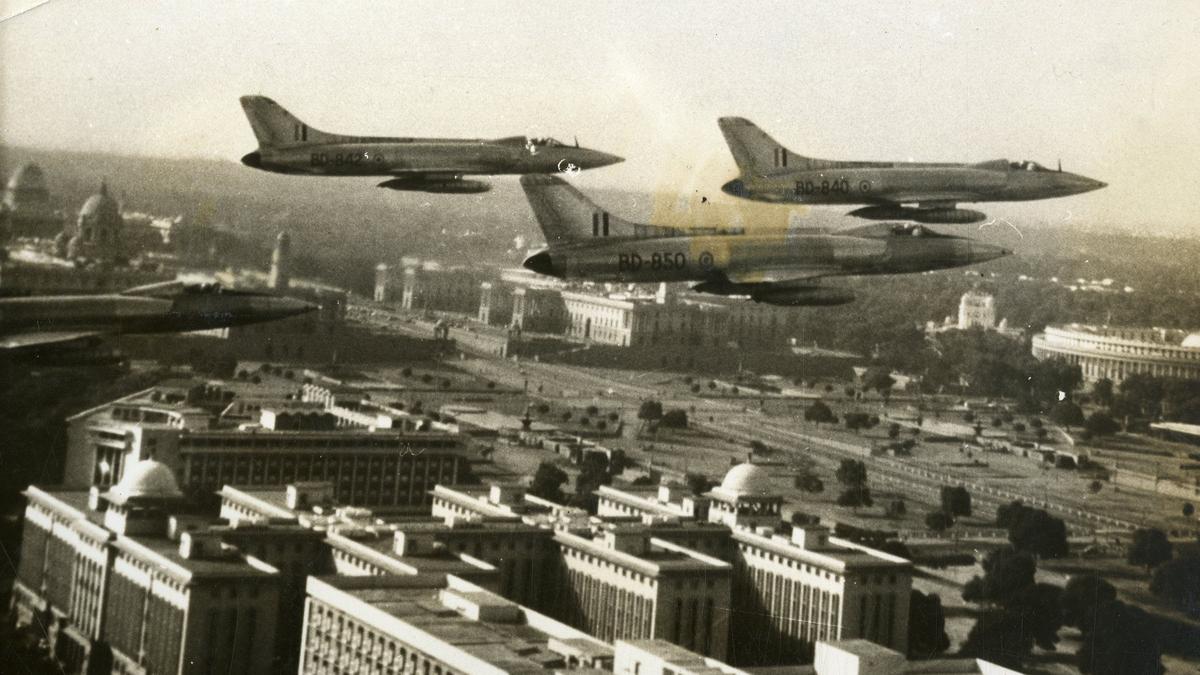The story so far: There has been growing excitement in military and industrial circles over the fast-tracked indigenous fifth generation stealth Advanced Medium Combat Aircraft (AMCA). Touted as a multi-role fighter with super-cruise capability, internal weapons bays, advanced avionics, and diverter-less supersonic intakes enhancing stealth and reliability, the AMCA is being hailed as a milestone in Indian aerospace history. However, a dose of historical realism is warranted particularly since India has a persistent propulsion gap, and is overly reliant on imported engines. Nearly seven decades of fighter development reveal cautionary lessons, starting with India’s first indigenously designed fighter jet, the HF-24 Marut (Spirit of the Tempest).
What happened to the HF-24 Marut?
Launched in the 1950s by Hindustan Aeronautics Limited (HAL) under famed German engineer Kurt Tank — designer of several WWII Luftwaffe fighters — the twin-engine, swept-wing Marut was, like the AMCA, an ambitious project of its time. Sleek and capable of transonic speeds, it embodied post-colonial India’s drive for self-reliance and entered service amid high hopes in the late 1960s.
However, the Marut never reached its full potential, not because of design flaws, but entirely due to its underpowered British Bristol Siddeley Orpheus 703 turbojets. Although Tank had envisioned a more powerful engine, it never materialised, leaving the Marut’s performance underwhelming. And, while it performed reasonably well in ground-attack roles during the 1971 war on the western front, its propulsion limitations ultimately proved crippling. HAL produced only 147 of these high-maintenance, low-output fighters, which were eventually ‘number-plated’ or retired by 1990.
Indian Air Force (IAF) veterans who flew the Marut consistently cited the lack of a powerful engine as its Achilles’ heel — highlighting the enduring reality that high-end fighters live or die by propulsion technology. Engines, after all, are not mere technical parts but the core of sovereign aerospace capability, shaping a combat aircraft’s power, range, and mission effectiveness.
Did India develop its own engines?
Following the Marut’s disappointing engine performance, the Defence Research and Development Organisation (DRDO) assigned its Gas Turbine Research Establishment (GTRE) laboratory in 1989 to develop the Kaveri GTX-35VS afterburning turbofan for the Light Combat Aircraft (LCA), which had been under design development since 1981-82.
Over the next 35 years, GTRE spent around ₹2032 crore, as of 2020, on the project, but without success. Despite producing nine full-scale prototypes and four core engines — logging over 3,000 hours of ground testing and 73 hours of flight trials on an Ilyushin IL-76 flying test bed in Russia — the Kaveri failed to meet the LCA’s performance benchmarks. It struggled with thrust-to-weight ratio, reliability, and thermal management under sustained high-performance conditions. Though spinoff versions were proposed for tanks, ships, and locomotives, none have so far entered operational use.
A revival attempt in 2016, in collaboration with French engine-maker Snecma (linked to offset obligations from the IAF’s Rafale deal) also collapsed. A parallel proposal by its partner Safran to co-develop a new engine for the Tejas MkII and AMCA met a similar fate, reportedly rejected by the DRDO due to institutional pride.
Meanwhile, Kaveri’s failure forced the Aeronautical Development Agency (ADA), responsible for the LCA’s design, to adopt the U.S.-made General Electric (GE) F404-IN20 afterburning turbofan engine (producing 78-80 kN of thrust) around 2004. Although barely adequate — restricting Tejas’ payload and high-angle-of-attack capabilities — the engine was eventually approved by the IAF, which inducted two Mk1 squadrons from 2015 onwards, with one squadron operating without full operational clearance, nearly 34 years after the LCA programme’s inception.
How is India affected by engine dependency?
India’s engine dependency issues resurfaced recently when GE delayed delivery of 99 F404 engines by 13 months for the upgraded LCA Mk1A — a lighter, more capable variant equipped with an Active Electronically Scanned Array (AESA) radar, advanced electronic warfare suites, and mid-air refuelling capability. Under a $716 million contract signed in 2021, engine deliveries were scheduled to begin by March 2024, but the first power pack arrived only in April 2025, as part of an initial batch of 12 expected by the end of the year. GE cited “unprecedented supply chain pressures,” including disruptions from suppliers, as the cause for the delay, but for India it jeopardised the MK1As commissioning by deferring it further.
This triggered sharp criticism from Air Chief Marshal A.P. Singh, who publicly rebuked HAL for chronic slippages in fighter deliveries amid a steep decline in IAF combat strength from a sanctioned 42.5 fighter squadrons to around 30 presently. Further reductions loom with two legacy MiG-21 ‘Bis’ squadrons slated for imminent retirement. “We need to be now ready to be future-ready,” Mr. Singh said at the CII Annual Business Summit in New Delhi on May 29. Citing HAL’s blotted history of missed deadlines, he bluntly asserted that wars are won by equipping the military, not merely planning for the future.
Simultaneously, HAL’s negotiations with GE to locally manufacture the more powerful GE-F414 engine (90–96 kN thrust) — intended for the LCA Mk2 and initially the AMCA Mk1 — too has hit a roadblock. The deal, announced during Prime Minister Narendra Modi’s 2023 U.S. visit, has reportedly been stalled by GE’s demand for an additional $500 million over the original $1.5 billion agreement.
More critically, GE appears unwilling to share core engine technologies like single-crystal turbine blades, thermal barrier coatings, and advanced cooling systems, all of which are vital for boosting engine durability and thrust. HAL continues to demand full technology transfer, but industry insiders point out that such proprietary know-how, developed at great expense, is rarely shared by global engine makers. Talks, however, are still ongoing.
Both the LCA Mk2, which is under-development, and the initial AMCA Mk1 models are expected to rely on the F414 as a ‘stopgap’ powerplant, pending finalisation of the deal. The ADA is also scouting for a 110 kN-class engine for the AMCA Mk2, potentially via a joint venture. Intermittent discussions with France’s Safran and the U.K.’s Rolls-Royce have so far yielded no concrete outcome.
And, while these possibilities may serve as a short-term workaround, it reflects the same external engine dependence that had crippled the Marut. Consequently, a cross-section of IAF veterans and aerospace experts warned that unless India developed an indigenous engine to power future AMCA blocks, the programme risks being held hostage once again to geopolitical whims.
How much is India dependent on external engines?
India’s external propulsion sourcing extends well beyond aerial platforms, affecting the Army and Navy as well, both of which are exclusively reliant on imported power packs or foreign engines assembled and built domestically under licence. The Army’s Arjun Main Battle Tank, for example, is powered by the German MTU MB838 Ka-501 diesel engine paired with RENK RK-304 transmissions, while the recently trialled Zorawar Light Tank uses the U.S.-origin 1,000hp Cummins Advanced Combat Engine. The Navy too depends wholly on foreign propulsion systems — Russian, Ukrainian, French, German, and U.S. engines — that power all its indigenously designed and built frigates, destroyers, auxiliary vessels, troop carriers, corvettes, and fast attack craft. India’s all-round engine development across aerospace, land, and naval platforms is critical to ensure strategic autonomy and enhance military capability.
How important is autonomous engine development ?
Aircraft engine development is vital for India to achieve aerospace autonomy and strategic self-reliance. Disruptions in foreign engine supplies delay production like that of the LCA Mk1A, hampers upgrades, and restricts exports as that would necessitate third-party approvals. The U.S., France, and China are able to assert dominance in global aerospace markets as they have harnessed indigenous propulsion.
However, for India, mastering advanced jet engine technology is not merely a prestige project but is crucial to sustaining military readiness, ensuring credible deterrence, and insulating its defence sector from external shocks and global political vagaries. Without this core capability, India’s broader ambitions in aviation and defence exports risk remaining perennially compromised.
A broad spectrum of defence experts and IAF veterans contend that India’s failure to develop advanced jet engines transcend technical hurdles and are fundamentally a political challenge. India’s defence funding remains fragmented, largely focused on short-term projects, rather than being driven by a long-term, strategic vision.
If India is genuinely committed to closing this glaring capability gap, mere slogans like Atmanirbhar Bharat will not suffice. Achieving true autonomy in engine technology demands comprehensive structural reforms, unwavering political will, and the cultivation of an innovation ecosystem which will seamlessly integrate private sector participation, academic research, and defence R&D institutions into a cohesive and competitive framework.
Rahul Bedi is a veteran journalist based in New Delhi and Chandigarh specialising in military, defence and security matters.
Published – June 20, 2025 08:30 am IST






